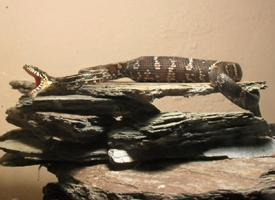
Váhy a míry
| Délka | od 8 do 100 cm |
|---|
Stav ohrožení
| Ohrožen |
Popis zvířete
The Dice snake (Natrix tessellata) is a fascinating and relatively less-known species among the colubrid snakes. Named for its unique, dice-like patterning on its scales, this non-venomous snake is a subject of interest for both herpetologists and nature enthusiasts. This reptile possesses a range of characteristics and behaviors that make it a unique species in its habitat.Physical Description
The Dice snake typically reaches lengths of between 70 to 100 centimeters, though some individuals can grow up to 140 centimeters. Its body is elongated and slightly robust, adapted for both terrestrial and aquatic environments. The skin is covered in smooth scales that display a distinctive pattern reminiscent of a checkerboard, with dark spots arranged against a lighter background. This pattern is more pronounced in juveniles and tends to fade as the snake matures. The coloration of its body can vary from grayish-green to brown, providing excellent camouflage against the backdrop of its natural surroundings.
Habitat
Dice snakes are predominantly found in Europe and parts of Asia, thriving in a variety of aquatic habitats. They show a strong preference for clean, slow-moving or still waters, such as lakes, ponds, rivers, and marshes. These snakes are often seen basking on rocks, logs, or riverbanks, soaking up the sun's warmth. However, they are quick to dive into the water at the slightest hint of danger.
Diet and Hunting Behavior
Specializing in an aquatic diet, the Dice snake primarily feeds on fish and amphibians. It has developed an exceptional ability to hunt in the water. Using its keen eyesight and swift movements, the Dice snake can catch its prey with remarkable precision. After capturing a fish, the snake will typically swallow it head-first to avoid being injured by the fish's fins.
Reproduction
The Dice snake is oviparous, meaning it lays eggs. Mating occurs in the spring, following their emergence from hibernation. Females lay between 10 to 30 eggs in early summer, often in decomposing plant matter to provide warmth necessary for incubation. The eggs hatch in late summer or early autumn, with the young snakes being fully independent from birth, ready to hunt and fend for themselves.
Conservation Status
While the Dice snake is not currently listed as endangered, its populations are facing pressures from habitat destruction, pollution, and human encroachment. Clean water bodies are essential for their survival, making them vulnerable to the effects of water pollution and the alteration of their aquatic habitats. Conservation efforts are focused on preserving their natural habitats and ensuring water bodies remain clean and free from pollution.
Behavior and Adaptations
Dice snakes exhibit remarkable adaptations that facilitate their aquatic lifestyle. They are excellent swimmers and can hold their breath underwater for long periods while hunting or evading predators. During the colder months, they hibernate in crevices or burrows to escape the cold. Dice snakes are generally shy and will avoid confrontation with humans or larger predators. When threatened, they may attempt to flee or, if captured, emit a foul-smelling substance from their anal glands as a defense mechanism.
In conclusion, the Dice snake is a captivating species with its unique patterning, aquatic prowess, and intriguing behaviors. Despite its resilience and adaptability, it faces challenges from environmental changes and human activities. Understanding and protecting the natural habitats of the Dice snake is crucial for its continued survival in the wild.
Podobná zvířata
Nové fotografie zvířat
Top 10 zvířat
- Dolphin gull (Leucophaeus scoresbii)
- Diana monkey (Cercopithecus diana)
- Moustached guenon (Cercopithecus cephus)
- Galápagos tortoise (Geochelone nigra complex)
- Stone loach (Barbatula barbatula)
- Japanese macaque (Macaca fuscata)
- Russian tortoise (Testudo horsfieldii)
- Greek tortoise (Testudo graeca)
- Common flying dragon (Draco volans)
- Vendace (Coregonus albula)


